Ask a question from expert
Data Analysis and Design - Doc
35 Pages6900 Words124 Views
Added on 2020-10-04
Data Analysis and Design - Doc
Added on 2020-10-04
BookmarkShareRelated Documents
Data Analysis andDesign
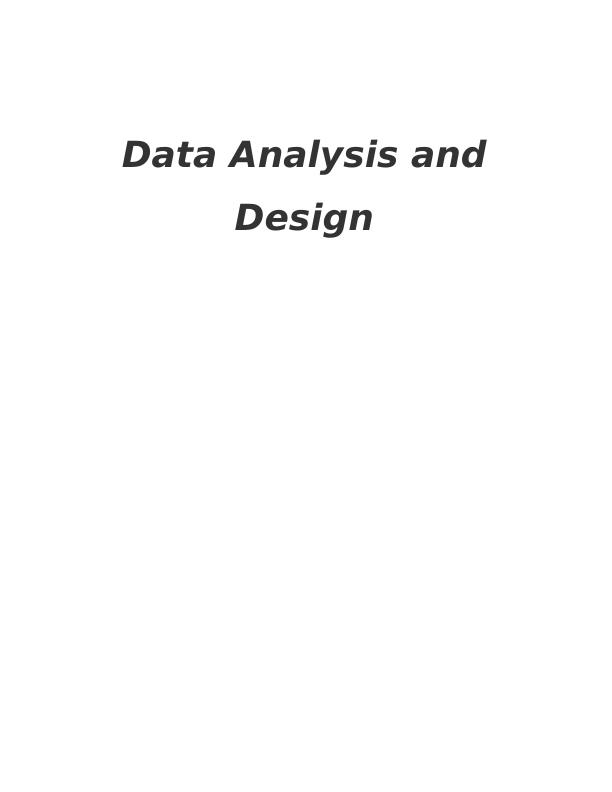
Table of ContentsINTRODUCTION...........................................................................................................................1LO1..................................................................................................................................................11.1 Comparison between integrated database system and traditional file processing system....11.2 Examine case material that focuses on developments such as data mining and datawarehousing................................................................................................................................31.3 Analyse the different approaches to database design............................................................6LO 2.................................................................................................................................................82.1 Apply data analysis and design techniques to develop a fully relational database withminimum of six tables.................................................................................................................82.2 Verify that a design meets user requirements and provide justification of the databasedesign..........................................................................................................................................82.3 Database tools and techniques to demonstrate a more advanced level of understanding andapplication...................................................................................................................................9LO 3...............................................................................................................................................113.1 Incorporate a query language/languages into the database design......................................113.2 Use a range of visual tools to enhance the database design................................................113.3 Demonstrate the extraction of meaningful data through the use of query tools.................11LO 4...............................................................................................................................................114.1 Provide documentation to support the database implementation........................................114.2 Data verification and validation..........................................................................................124.3 Evaluate a range of testing techniques and apply one to your own database design..........14CONCLUSIONS............................................................................................................................17REFERENCES..............................................................................................................................18
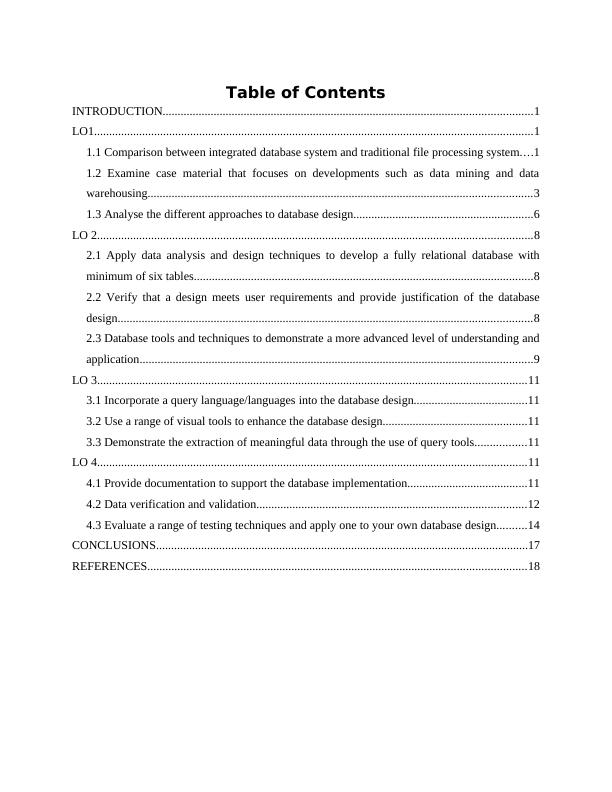
INTRODUCTIONData analysis and design can be determined as the process of inspecting, transformingand designing the framework of data which is aimed at discovering the useful informations andconclusions at the end. This can be applied after writing the program which is helpful inunderstanding and defining the data which will be later going to processed by the software. Thisreport will help in providing the integrated database traditional file processing environment ascompared to new technology. The study will also help in analysing different approaches ofdesigning the database. It will also help in developing the database design in order to createrelational database system. This research will also help in incorporating the query language intothe database design using Visual tools and techniques. After the application of all the tools andtechniques into the database in order to design a structure for insertion of values into it, the studyhave also explained various implementing techniques. The report have also covered variousareas such as application of validations and verifications so that the user cannot insert invalidvalues into the database.Furthermore, it will also going to create a clear understanding about the extraction ofmeaningful data which can be obtained through the use of wide range of query tools. The studywill also throw some light on various range of techniques which needs to be applied at the timeof testing the database software. These techniques will help in developing effective design of thesoftware.LO11.1 Comparison between integrated database system and traditional file processing system Managing the huge information in an organisation can be carried out by implementing a properstructure and design in order to allow the interaction of users. This can be possible when thedevelopers provide a proper database design or structure as an interface to interact with naïveusers. Database Design can be comprised of different data modelling concept which helps inapplication of various steps in order to develop a high level and abstracted design phase of thesoftware.Traditional file processing system was an early attempt which helps in computerizing thedata manually. In early file processing system organisations generally use flat file system, to1
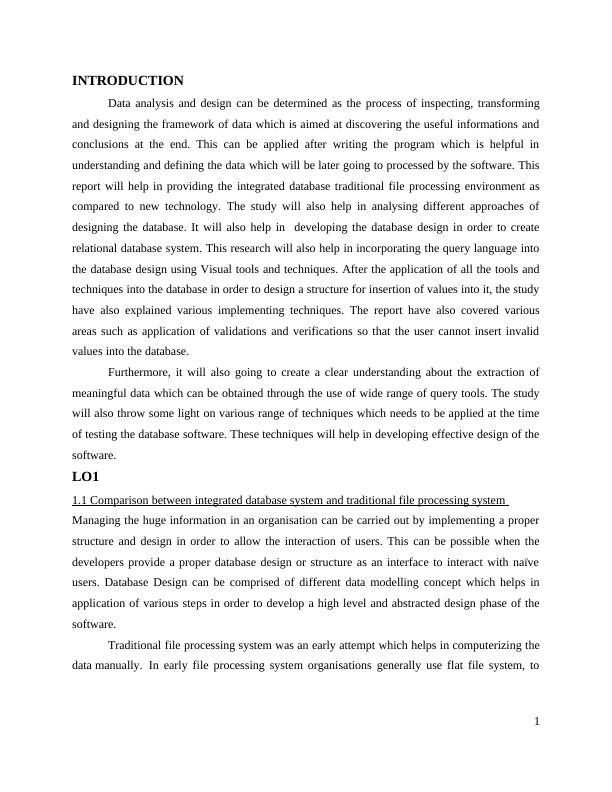
store database. These manual filling system mainly works well when there are less number ofitems needs to be stored in the database. Khuge database increases the complexities of managingthe large dataset. As the advancement of technology have rapidly grown, various file storingmethods are also established in order to store huge database automatically. This manually filefilling system was replaced by various database designs which are implemented using variousSystem development life cycle phases.If St Patrick college use traditional file processing system then, there are certainlimitations which can be overcome by using a database system. These limitations and drawbacksare as follows: In file system there are higher possibilities that same data is stored multiple times thusthere is higher tendency of data redundancy and duplication. If college will use databasesystem then data validation and verification techniques can overcome this problem.Database system reduce the data redundancy by keeping single copy of data andproviding access to multiple users so that consistency can be maintained (Chandra andet.al., 2015). In file management systems if any changes are made in access methods or physicalrepresentation then there is additional requirement of modification to applicationprograms. This dependency make it difficult for the user to manage data due to limitedflexibility. On the other hand if St Patrick college will use database system then there isno dependency of data (Difference Between File Processing System and DatabaseApproach, 2016). Instead, the data can be easily shared and is of concurrent behaviour.So it will be easy for the college to analyse the performance of each player from all thegame events. The game management system of college requires managing complex data and interfilerelations between different events. The file processing system is not capable to providetools for data modelling of attributes from real world, hence database system can providerelational database (Coronel and Morris, 2016). Analysis of different data models and their contribution to database development 2
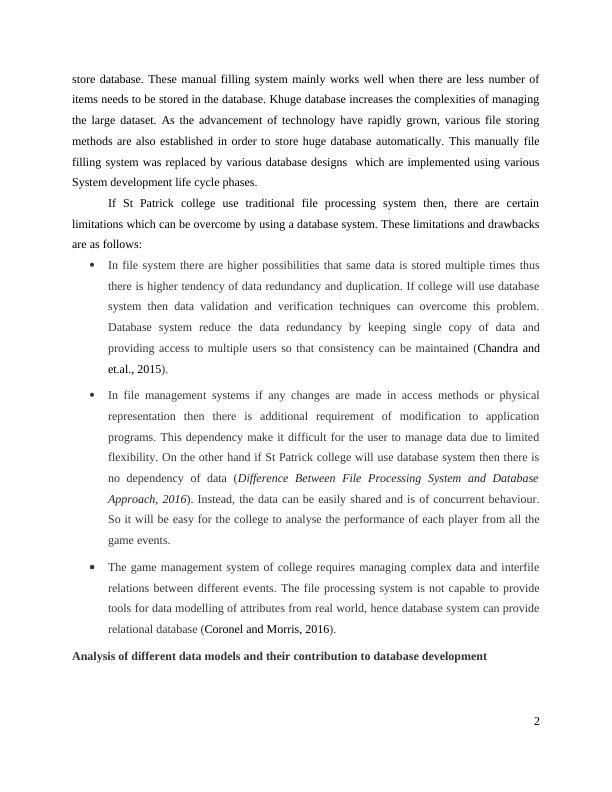
The data models represents the logical framework of the proposed database. It alsoexplains the ways to store and access data as well as the interdependency between data. Databaseof St Patrick college can be based upon data models. Relational database model: In this type of data model college can store its data in the form oftables consisting rows and columns. There can be one-to-one and many-to-many relationshipsbetween different tables. This type of database are written in SQL and can be easily normalised.This data model is the best suitable model for the database of college. As compare to other datamodels data fetching is very simple and quick in relational approach (Chitchyan and et.al., 2015).Hierarchical model: In this model data is managed in the form of hierarchy in which a singlerecord it considered as parent root and its sub records are arranged in a fixed order. Thisapproach is not efficient in managing operational efficiency thus may not be suitable for StPatrick college. The data uniqueness is difficult to achieve in this type of database thus if collegerequires accessing only unique elements then relational data can be considered as effectivebecause it ensures the avoidance of duplicate data by using keys. Entity relationship model: In this approach database is designed with concepts and is notconnected directly to the physical layer of database. All game events of college can be defined asthe entities which has attributes which are related with each other (Wu and et.al., 2014). Incomparison to relational data model it is easy to analyse the entity relations with this approach. These data models are considered as the essential elements in developing a database becausethese models describes the flow of data and how requirements of user can be fulfilled with themanagement of data relations. 1.2 Examine case material that focuses on developments such as data mining and datawarehousingData warehouse is defined as the relational database which is used for analysis and query insteadof transaction processes. On the other hand data mining is termed as approach which candiscover relations and patterns between various data. These tools are important for the3
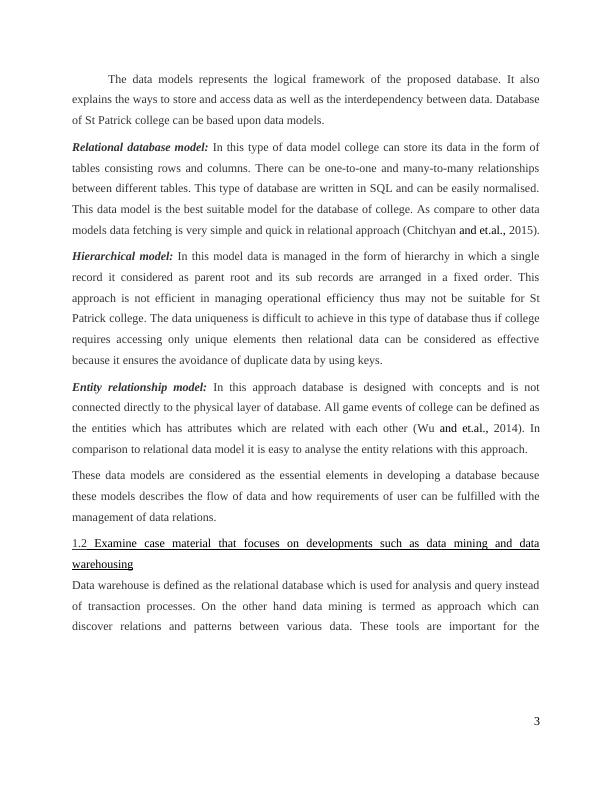
developing database of St Patrick college so that college can achieve its requirement and its datacan be managed effectively. Data warehouse (DW):In order to support the management process of database system of St Patrick college nonvolatile and subject oriented collection of data is essential. This is used to gather data fromvarious sources so that it can be analysed (Stonebraker, Deng and Brodie, 2017). This evaluationcan be used by the college to make decisions. Thus, it is able to provide a correlation betweendifferent data from the current system. Though database and DW both are form of relationalsystems but servers different purpose. The DW consist of inbuilt data resources which canmodulated upon transaction of data. Characteristics of data warehousing: The data warehousing is subjective and thus it works more on functionalities or datawhich are defined in details. DW system gathers data from various sources so that data can beanalysed and reported for making decisions. Though database and ware housing both arerelational system but they serve different goals (Klochkov and et.al., 2016). DW aims at storinghuge quantities of historical data and to execute queries quickly. The warehousing consist ofinbuilt data resources which are modulated by transaction of data. Characteristics and functionality of data warehousing:DW process aims at a specific processes which demonstrates it subjects orientedbehaviour. It is executed by the data which is managed by the large tables. The non-volatilenature of the warehousing enables its users to understand and analyse the changes in data so thatobjectives of creating database can be accomplished. Warehousing can also be considered astime variant and thus time limits are also taken into account in data modulation. DW serves thefunction of repository and can provide back up services to data of St Patrick college with costeffective approaches. Thus, it serves the functions of data integration and cleaning along with thedata consolidation (Hoffer, Ramesh and Topi, 2016). Application and implementation: 4
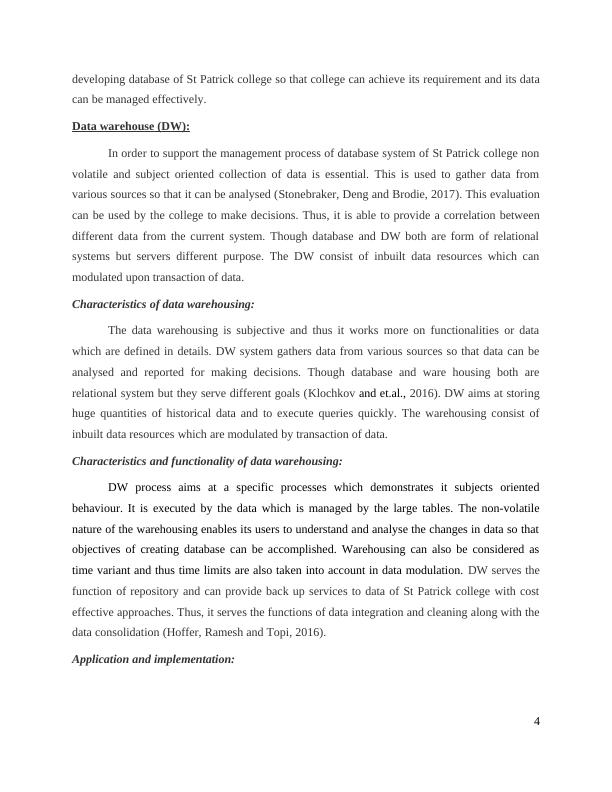
St Patrick college can use warehousing to carry out data mining so that informationstored in database can be analysed even when data volume is very high. For the game event ofthe college huge number of students will register in variety of games thus number of datatransactions will also be high. To manage the game analytics and details of participants so thatthey can be mined college can use data warehouse (The Benefits of Data Warehousing andExtract, Transform and Load (ETL), 2016). The game logs and activities are in bulk thus DWcan easily tune for accessing the updates. The data warehouses are implemented in three phases.In first phase strategies and requirements of college are analysed so that transformation and datamapping can be accomplished. On the basis of subjective area implementation is divided intophases and then each phase is integrated. Instead of applying big bang method iterativeprototyping and testing is used for implementing data warehouse (Parks and Hall, 2016). Advantages and disadvantages of DW: The data warehouses can handle bulk amount of data and can give consistency byeliminating errors. To enhance the decision making and business intelligence it processes querieswith various options along with security. Thus, it provides data consistency and make it possibleto timely access the data securely. However, the warehousing can promote certain disadvantagessuch as increased time requirements to report, reduced data flexibility and compatibility issueswith existing systems. Data mining: This technique can be used to determine the useful data pattern from the huge amount ofdata stored in database of data warehouse. The pattern recognising ability of mining techniqueswill enable St Patrick college to detect error or any kind of unusual activity in the database(Hoffer, Ramesh and Topi, 2016). On the basis of identified pattern of data the users can alsoanalyse their relationships between data. The traditional process of data analysis can providesolutions to a problem only when end user identifies any issue while contrary to this data miningis proactive process which determines characteristics and interdependencies of data so thatanomalies and errors can be detected before they influence the quality of the work or datamanagement. 5

Data mining techniques: In the developed database of St Patrick college following data miningtechniques can be used: Predictive modelling: In this data mining techniques training and testing approach is used. Thehistorical data is analysed so that relationships can be understood and on the basis of thislearning new models can be analysed or extracted (Dillon, 2015). Link analysis: This type of data mining techniques aims at building associations or links so thatdata characteristics can be evolved. The discovery of the links depends upon several attributessuch as sequential patterns, same time sequence discovery and discovery by association or merepresence. Database segmentation: In this mining approach database is divided into clusters which containssimilar records so that homogeneous nature can be used to enhance the accuracy of data. Deviation detection: This type of tools identify the possible deviation in the predefined norms orexpectations in the patterns of data. Visualisation techniques and statistic tools can be used forthis type of data mining approach. It is helpful in controlling quality and to avoid anyunauthenticated activities (Mitrovic and Suraweera, 2016). Pros and cons of database mining: The biggest disadvantage of data mining process is the security and privacy concerns.The mining techniques are not fully accurate thus they can also give misleading informationwhich can cause loss to the users. However, the application of these techniques can be helpful todetect the errors and suspicious activities which are encountered in the database or warehouses. Thus, data mining and warehousing techniques can make data management process of St Patrickcollege more efficient, easy, flexible and compatible with the existing system requirements. 1.3 Analyse the different approaches to database designVarious approaches to database design For designing the database of St Patrick college different designing approaches can beused which are discussed as below: 6
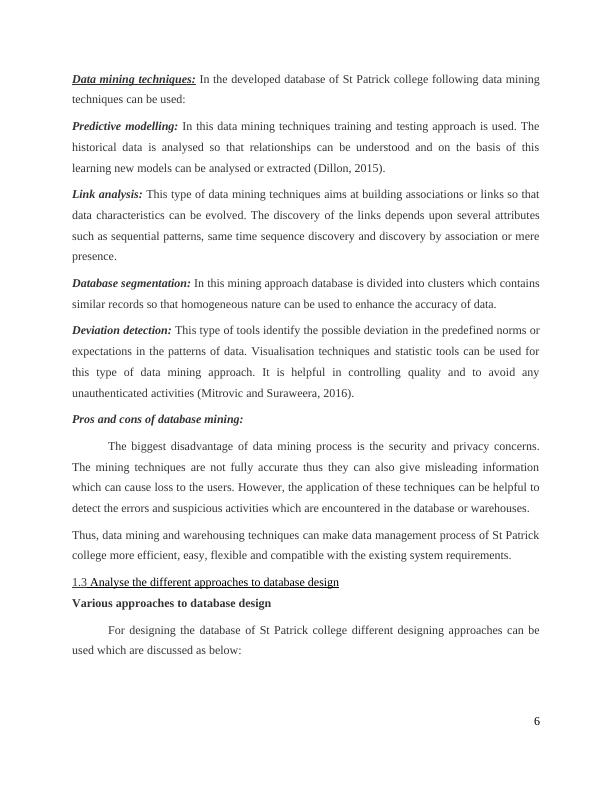
End of preview
Want to access all the pages? Upload your documents or become a member.
Related Documents
Data Analysis and Design TABLE OF CONTENTS INTRODUCTION 1 TASK 11 A.C.1.1 Introductionlg...
|36
|6604
|129
Data Analysis Design Sample Assignmentlg...
|25
|4475
|412
Report on Data Analysis and Design- Fast Track Health Centrelg...
|23
|5165
|232
Database Assignment 2022lg...
|101
|18699
|18
Database Technologies and Techniqueslg...
|11
|2612
|266
Database Design Assignment Solutionlg...
|41
|3865
|434